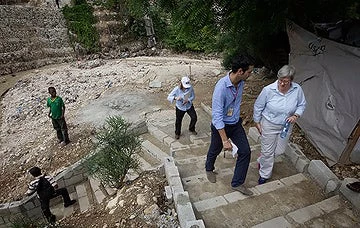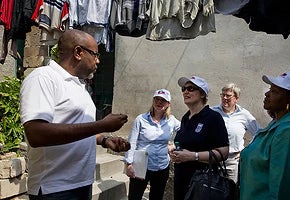Available in Français

The emptying expanse to the left was the story of success. More than three years after the massive earthquake that shattered so much of Port-au-Prince, Haiti, rental subsidies were moving households quickly out of camps to houses in the community.
It seems that this deceptively simple program stands a chance of emptying the camps of most households. Registers of eligible households in the camps are made, agreed by the government, the householders given criteria for their house search. When they find something, it is checked and, once verified, the household is given a one year rental subsidy, and off they go. Former renters, these households are checked in on at regular intervals up to one year out. So far, it takes households 1.5 house visits to find something they want, and they stay in them.
Those isolated shacks on the concrete - moving out more slowly - are risky. The levels of sexual and gender-based violence are high, and security has had to be tightened.
For those who own - a lottery in a country with no cadaster and contested land ownership everywhere - multiple programs are helping reconstruct homes to code. A blue stamp on the wall - the quality seal - is a source of pride and could be a source of greater equity if housing finance can be brought to the market at scale. Vendors are certified. From them, you will get cement, steel bars, and other building materials that meet the standard. In some projects, the community is engaged in mapping the community - understanding the zones that are the highest risk, and making decisions about communal facilities and beautification. The solar LED street lamps offer safety but also bring Haitians into the street, especially school children to do their homework.
This reconstruction wouldn't be possible without the painstaking work of surveying more than 400,000 properties in the immediate aftermath of the earthquake, something never done before and not possible without Global Facility for Disaster Reduction and Recovery (GFDRR) support for the World Bank.
The Challenges Ahead
Last year, Tropical Storms Isaac and Sandy within months of each other wiped out large parts of Haiti's agricultural production. This on top of drought (in a land more noted for rain, wind, and landslides) put Haiti in a perilous position as it prepares for what U.S. meteorological services project could be a particularly severe hurricane season. Getting as many people out of the camps and into safe houses in the next few months must be a priority.

With our efforts to mainstream disaster risk and resilience in our development work, including now in IDA17, much of what we have learned in Haiti and beyond is a model. There is a substantial focus on the private sector in the champions' work, beyond the need to maintain business continuity and keep the private sector operating in the days and weeks after a disaster strikes, but importantly in the insurance products, from microinsurance, housing finance and insurance, catastrophe risk and weather related insurance, to the risk awareness and other business models that can help move at speed and scale in recovery.
In Haiti, where disaster will come again and again over the next decade or more, resilience is key to economic growth, peace, stability, and human development. Building the institutional framework with the government so that they can prioritize and follow through, and encourage and direct the work of myriad NGOs and small business working from the bottom up is essential.
Now, through the Pilot Program for Climate Resilience of the Climate Investment Funds, Haiti will start accessing climate finance as well as humanitarian relief and development finance. Haiti needs all international partners to be singing from the same song sheet and, with the focus on government ownership, perhaps things can happen more quickly and smoothly.
For the family living in the camp, living in a red zone at the bottom of a ravine, or teetering on a bare hillside, where once smart houses stood before the earthquake, we have to all hope so.
Rachel Kyte
Vice President for Sustainable Development
www.worldbank.org/sustainabledevelopment
Twitter: @rkyte365
Photos: PNUD Haiti


Join the Conversation